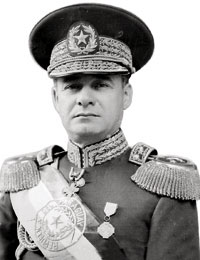José Félix Estigarribia facts for kids
Quick facts for kids
José Félix Estigarribia
|
|
|---|---|
 |
|
| 34th President of Paraguay | |
| In office August 15, 1939 – September 7, 1940 |
|
| Vice President | Luis Alberto Riart |
| Preceded by | Félix Paiva |
| Succeeded by | Higinio Morínigo |
| Personal details | |
| Born | February 21, 1888 Caraguatay, Paraguay |
| Died | September 7, 1940 (aged 52) Altos, Paraguay |
| Political party | Liberal Party |
| Spouse |
Julia Miranda Cueto
(m. 1917; plane crash 1940) |
| Alma mater | Trinity College of Agriculture |
| Military service | |
| Branch/service | Paraguayan Army |
| Years of service | 1911–1940 |
| Rank | |
| Battles/wars | Chaco War |
José Félix Estigarribia Insaurralde (born February 21, 1888, in Caraguatay – died September 7, 1940, in Altos) was an important Paraguayan military officer and politician. He was the top commander of the Paraguayan Army during the Chaco War (1932–1935). Later, he became the President of Paraguay on August 15, 1939. He served as president until his death in a plane crash on September 7, 1940.
Estigarribia is famous for leading Paraguay to victory in the Chaco War against Bolivia. He was a brilliant military strategist during the conflict. Because of his actions, he became a war hero. After his death, he was given the special rank of "Marshal of the Paraguayan Nation."
Contents
Early Life and Education
José Félix Estigarribia came from a humble family. His father, Mateo Estigarribia, was a farmer and silversmith. His mother was Casilda Insaurralde. He was born in a small town called San Roque, near Santa Elena.
He went to elementary school in his hometown. In 1908, he started studying at Trinity College of Agriculture. After getting his diploma, Estigarribia decided to change his career. In 1910, he joined the army as a lieutenant in the infantry.
Military Career Before the War
After joining the army, Estigarribia received more training. He studied in Chile from 1911 to 1913 at the Military School of Bernardo O'Higgins. In 1917, he was promoted to captain. He played a key role in the 1922 revolution in Paraguay. After that, he was promoted to Major.
Because of his skills, he was chosen to attend a special three-year course. This was at the École Supérieure de Guerre in Paris, France. There, he learned from famous generals like Maurice Gamelin and Marshal Foch. Estigarribia finished his studies with excellent grades. When he returned in 1928, he became the Chief of Staff of the Army.
Less than a year later, he was removed from this position. This happened because he disagreed with the government's plan for defending the Chaco region. He believed that instead of just holding the land, the main goal should be to defeat the enemy. However, as war with Bolivia seemed unavoidable, the government realized they needed his skills. Lieutenant Colonel Estigarribia, then 44 years old, was sent to the Chaco.
Leading the Chaco War
The Chaco War was a conflict where controlling communication lines was very important. Estigarribia believed that managing space and time would be key to winning. He convinced the Paraguayan government to start a surprise attack. This happened from September to December 1932. This was before Bolivia could fully prepare its forces.
As the commander-in-chief of the army, Estigarribia led the operations. He played a brilliant part in the Chaco War (1932-1935). His strategies and tactics are still studied by military academies worldwide. He stopped the Bolivian army from moving towards the Paraguay River. He also defeated strong enemy divisions. He did this by cleverly using both fixed positions and guerrilla fighting styles.
Under his command, the Paraguayan army made a huge effort. They led a very successful military campaign against the Bolivian army. The Bolivian army had more soldiers and resources. Estigarribia's army pushed them back to the Rio Parapiti. His ideas about moving armies, the importance of supplies (especially water), and surprising the enemy were very advanced. He also knew the enemy and the land very well. These qualities made him one of the top military leaders between the two World Wars. He made the most of his officers and showed the brave spirit of a Paraguayan soldier.
He led the Paraguayan Army as a colonel during the first year of the war. After winning battles at Campo Grande and Pozo Favorite, he was promoted to general. After his death in 1940, he was promoted to the rank of marshal. This was to honor his service in defending the Chaco.
Becoming President and His Legacy
After the war, Estigarribia was elected president. He started his four-year term on August 15, 1939. About six months later, on February 19, 1940, Estigarribia made a big change. He closed the legislature (the law-making body) and stopped the Constitution. He said that Paraguay was "on the edge of horrible anarchy." He promised that democracy would return once a new, working constitution was created.
However, this promise did not come true. Within five months, he changed the constitution. The new document gave the president a lot of power. The president could act for what he thought was best for the country. The legislature's powers were greatly reduced. This new constitution was approved in a vote in August 1940. It basically made Estigarribia's presidency a legal dictatorship.
On September 7, 1940, Estigarribia and his wife, First Lady Julia Miranda Cueto, were traveling. They were on a tour of the countryside. On a trip from Altos to his home in San Bernardino, their plane crashed. Everyone on board died. Higinio Morínigo became the next president. Estigarribia was given the rank of marshal after his death. His strong constitution stayed in effect until 1967. It was then replaced by another similar document, which lasted until 1992.
See also


